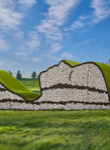Whether in landscapes, still lifes, or botanical illustrations, plants have a significant presence in art. How plants have been depicted in art matters. The long history of plant representation has influenced the ways in which societies look at and interact with plants. Through lectures, visits to The Morton Arboretum’s special art collections at the Sterling Morton Library, and walks around the Arboretum’s grounds, this class will look at the ways that art has shaped perceptions of plants, and how that perception has shifted over time with new cultural and scientific understandings.
In this class you will:
- Become familiar with how plants have been depicted within a Western art historical tradition, with an emphasis on imagery from the 18th century to the present.
- Understand the ways that these historical modes of representing plants have influenced how many people see, understand, and interact with plants today.
- Begin to think about your own relationships to specific plant species and broader ecologies, especially in terms of the historical contexts that have shaped them.
- Learn skills of visual analysis to examine artworks beyond those discussed within the scope of this class.
This three-week study will enrich the art appreciator, the nature lover, and the artist by considering the relationship between humans and nature as expressed through art.
This program meets in person at the Arboretum.
Instructor: Jessica Landau, art historian, University of Chicago
Age: 16 and older
Course number: A400































































































